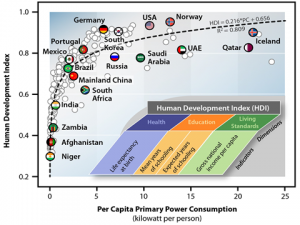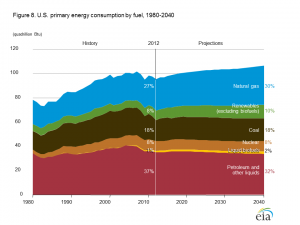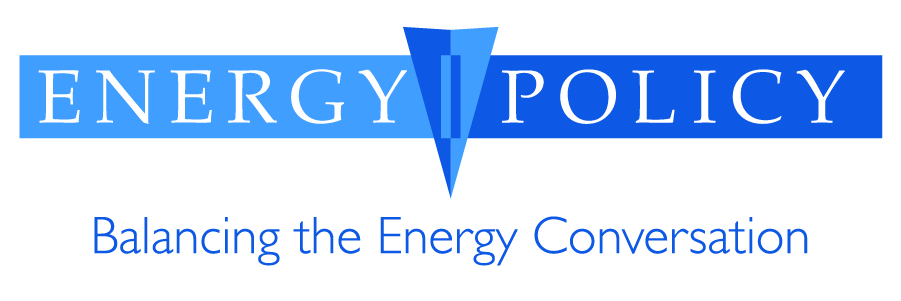By Douglas C. Sandridge, EnergyPolicyUs.org
February 11, 2015
Part 1 of 5 – FEEDING THE ENERGY BEAST & THE DELUSORY DEMISE OF FOSSIL FUELS
Regardless of where one stands in the existential debate over the continued use of fossil fuels, the fact still remains that the world runs on energy. A small minority of people opine for a return to a primitive past where energy is scarce. Many others are part of a ground-swell of support for “renewable” energy to replace fossil fuels. Some ascribe to the belief that fossil fuels can be replaced by renewable energy relatively easily and quickly if “just given a fair chance.” Some simply view the parlay as nothing more than a simple choice between using fossil fuels and not using fossil fuels. Notwithstanding the phantasm of a world devoid of fossil fuels, in reality, there is no so-called “choice.” At this moment in time, there is simply not a coherent and plausible means by which the United States (or the World) could totally eliminate the use of fossil fuels.

There is a strong statistical correlation between energy consumption and prosperity. Countries which use small amounts of energy are almost uniformly poor. Inversely, nations which consume copious amounts of energy are substantially wealthier. Likewise, there is a strong statistical correlation between energy consumption and the Human Development Index. The Human Development Index is “…..a summary measure of average achievement in key dimensions of human development: a long and healthy life, being knowledgeable and have a decent standard of living.” Nations which use small amounts of energy universally score low on the Human Development Index. Countries which use large amounts of energy are clustered at the high end of the Human Development Index. During the next few decades, we can expect that the energy growth rate in developing nations will remain high. Conversely, over the past 45 years, the amount of energy needed per $ of Gross Domestic Product (“energy intensity”) has been decreasing modestly in Europe and North America. This is a positive and notable mega-trend worthy of sustaining; however, this energy-intensity trend, in and of itself, is not sufficient to fundamentally change the tight statistical correlation between energy consumption and wealth, nor is it likely that a reduction in energy intensity will significantly reduce fossil fuel consumption over the next decade.

The U. S. Energy Information Administration (EIA) has released its Annual Energy Outlook 2014 (AEO2014). According to AEO2014, fossil fuels (petroleum, natural gas & coal) accounted for 82 percent of total United States energy needs during 2012. The sheer magnitude of the United States’ reliance on fossil fuels makes it almost impossible to overstate the importance of fossil fuels to the current national and world economy. If fossil fuels were somehow eliminated without a safe, reliable and affordable alternative, it would be equally difficult to overstate the devastating impact on our quality of life and social institutions. The ensuing anarchy and national mayhem might resemble downtown New Orleans in the immediate aftermath of Hurricane Katrina. During the next 25 years, the national and global appetite for energy will not abate. We are right to aspire to greater energy efficiency, lower energy intensity, and an expanded use of renewable energy. We can and should continue to invest a reasonable amount of human and financial capital in pursuit of the development of safe, reliable and affordable renewable energy; nevertheless, the titanic ship of fossil fuel consumption will take an agonizingly long time to arrest.
 AEO2014 forecasts that total energy consumption in the United States will rise modestly during the next 25 years and that the percentage of energy provided by renewable resources in the United States will increase from 9 percent to 12 percent by 2040 (an increase of 33%). Put into perspective, increasing the use of renewable energy by the amount projected by AEO2014 would only reduce U. S. dependence on fossil fuels from 82 percent to 80 percent of total energy consumed by 2040. If EIA’s current projections are remotely accurate, we will certainly not enjoy the elimination of fossil fuels before mid-century.
AEO2014 forecasts that total energy consumption in the United States will rise modestly during the next 25 years and that the percentage of energy provided by renewable resources in the United States will increase from 9 percent to 12 percent by 2040 (an increase of 33%). Put into perspective, increasing the use of renewable energy by the amount projected by AEO2014 would only reduce U. S. dependence on fossil fuels from 82 percent to 80 percent of total energy consumed by 2040. If EIA’s current projections are remotely accurate, we will certainly not enjoy the elimination of fossil fuels before mid-century.
EIA’s AEO2014 forecast is not welcome news for those who aspire to a future free of fossil fuels. Almost certainly, the United States’ development of renewable energy will exceed the AEO2014 forecast. In the spirit of youthful optimism, let’s indulge ourselves and speculate that somehow the United States could triple the percentage of renewable energy used in the United States over the next 25 years from 9 percent to 27 percent of total consumed energy (that increase would be 6 times greater than EIA’s current projection). By almost any measure, tripling the percentage of renewable energy used in the United States by 2040 would constitute a monumental accomplishment. Nevertheless, even if we could accomplish such a grand feat within the next 25 years, the United States would still need to use fossil fuels for an astonishing 65 percent1 of its total energy needs in 2040. Perhaps during the next 25 years, humankind will be blessed with the commercialization of nuclear fusion or benefit from other quantum leaps in battery technology or other energy technologies. We certainly have a profound duty to continue vigorously pursuing cleaner forms of energy for our children and grandchildren. We should honor those who seek to forge a cleaner energy future; however, it is not likely that we will eliminate fossil fuels within the next two decades. Part II of this series Reliability & The Clean Electricity Paradigm will appear February 18th on EnergyPolicyUs.org.
Note 1: Current renewables = 9% of total U.S. consumption; Renewable use by 2040 if current rate is tripled = 27% of total U.S. energy consumption; Theoretical renewables 27% + nuclear 8% = 35% by 2040; Remaining energy consumption attributable to fossil fuels = 65%


